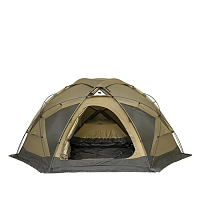Cart
Hammock Tents: A Beginner's Buying Guide
Introduction:
When it comes to outdoor adventures, hammock camping has gained popularity among outdoor enthusiasts. Hammock tents provide a unique and comfortable sleeping experience while allowing you to enjoy the beauty of nature. In this beginner's buying guide, we will explore the key factors to consider when purchasing a hammock tent, including its design, features, materials, and compatibility with wood stove equipment. Whether you're a seasoned camper or new to the world of hammock camping, this guide will help you make an informed decision and choose the perfect hammock tent for your outdoor escapades.
Section 1: Understanding Hammock Tents
Hammock tents are a lightweight alternative to traditional camping tents. They consist of a suspended hammock-like structure that provides a comfortable sleeping area, and often come with built-in mosquito nets and rainfly covers. The design of a hammock tent allows for easy setup, versatility, and minimal impact on the environment. These tents are especially popular among hikers, backpackers, and those seeking a more immersive outdoor experience.
Section 2: Selecting the Right Hammock Tent
2.1 Types of Hammock Tents
2.2 Considerations for Hammock Tent Selection
When choosing a hammock tent, there are several factors to keep in mind. These include the weight capacity, dimensions, ease of setup, durability, and the presence of additional features such as gear storage pockets, interior loops, and attachment points for accessories. It's essential to consider your camping style, expected weather conditions, and the number of occupants the tent can accommodate.
Section 3: Materials and Construction
3.1 Hammock Materials
3.2 Suspension System
The suspension system is a crucial component of a hammock tent. It consists of straps, carabiners, and adjustable lines that secure the hammock to trees or other anchor points. When selecting a hammock tent, consider the strength and adjustability of the suspension system, as well as its compatibility with different tree sizes and types.
Section 4: Compatibility with Wood Stove Equipment
4.1 Stove Jack Integration
4.2 Safety Considerations
When using a wood stove inside a hammock tent, safety should be a top priority. Ensure that the tent is made from fire-resistant materials and that the stove jack is properly positioned to prevent any risk of fire or burns. It's crucial to follow the manufacturer's instructions for safe use and maintenance of the stove and tent combination.
Section 5: Tips for Hammock Camping Beginners
5.1 Proper Insulation
5.2 Choosing the Right Campsite
5.3 Practice Setup and Takedown
Before heading out on your camping trip, it's advisable to practice setting up and taking down your hammock tent. Familiarize yourself with the process, including adjusting the suspension system, attaching rainfly covers, and securing all the necessary components. This will save you time and frustration when you're out in the wilderness.
Conclusion:
- Contact Us
-

About Pomoly
Pomoly is a leading camping brand specializing in hot tents and tent stoves. We are camping life explorer, Follow Page / Join Group, let's make camping enjoyful together!
Working Hours
Mon-Fri, 09:00 - 17:00

- Company Info
- NEWS
- About us
- Pomoly Name
- Leave-No-Trace
- Contact Now
- Facebook Group
- YouTube Learning
- Contact Us
- Topic Collections
- Policies & Terms
- Payment Policy
- Shipping Policy
- Return & Refund
- Privacy Policy
- Terms of Use
- Tax Policy
- Website Disclaimer
- Safety Disclaimer
- Warranty Policy
- Promotion Policy
- Pre-order Policy
- INTELLECTUAL PROPERTY RIGHTS
- Dealers Agreement And Terms
- Become Affiliate
- User Center
- Forget Password
- My Orders
- Tracking Order
- My Account
- Register
- Popular Searches
-
Tipi Tents Dome Tents Camping Tent Hammock Stove Camping Camping Pellet Stove Circle 6 Titanium Water TankDome X Locomotive 20 LEO 2 camping tent T-Brick 2.0 T1 2.0 tent stove Dweller wood stove Oroqen 2.0 Chimney Water Tank Lumberjack STOVEHUT Bromance 70 Tipi Pomoly Coupon Baker Oven Stove Titanium elbow Fire Pits Tent Stove titanium Stove Outdoor Pellet Stove
keebon pellet stove






